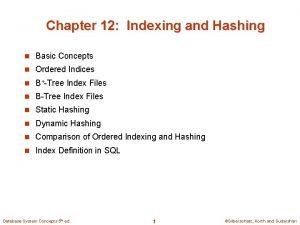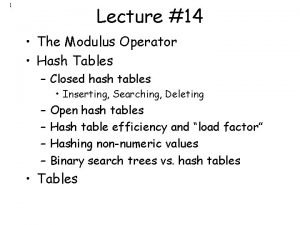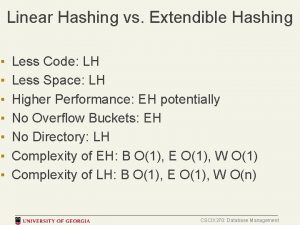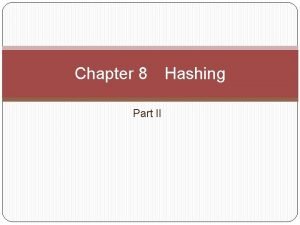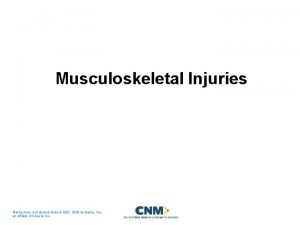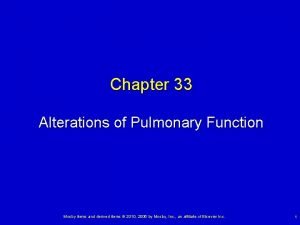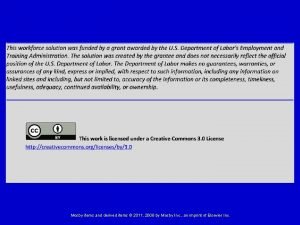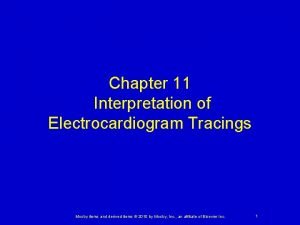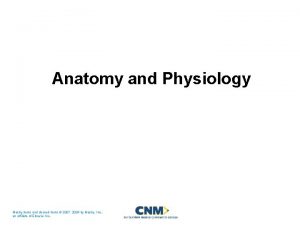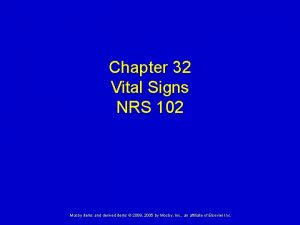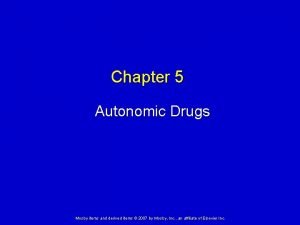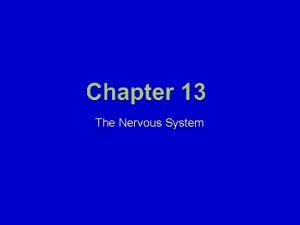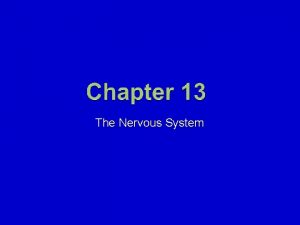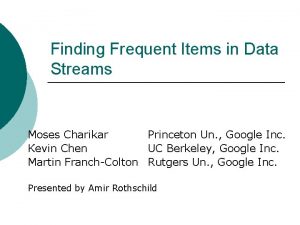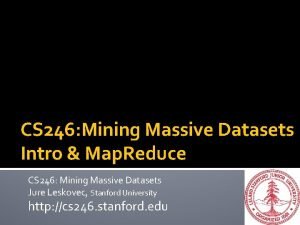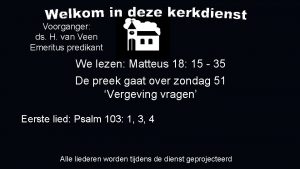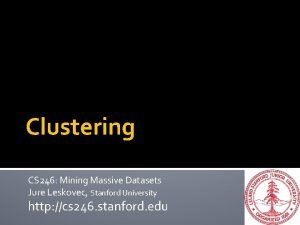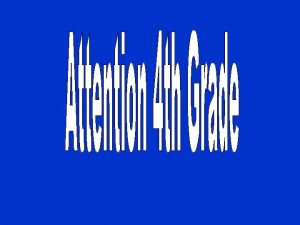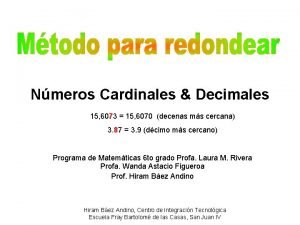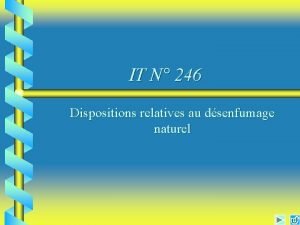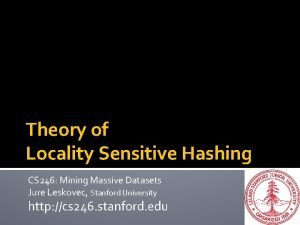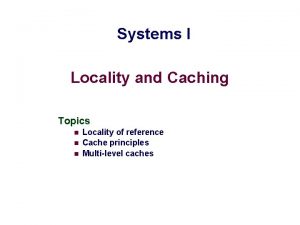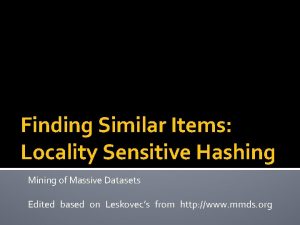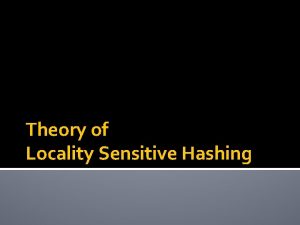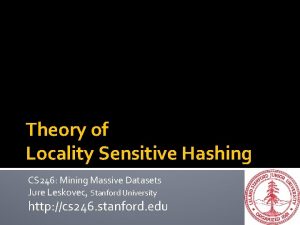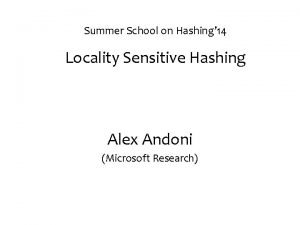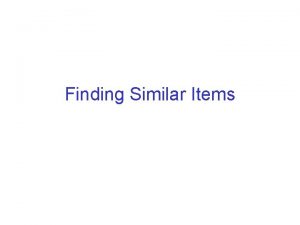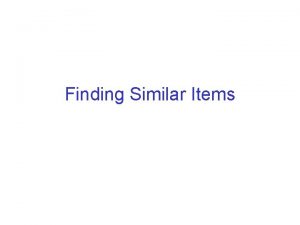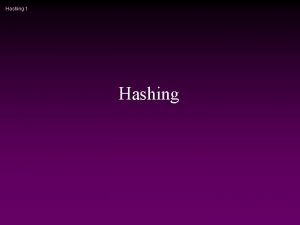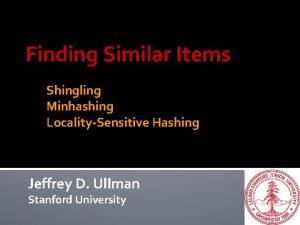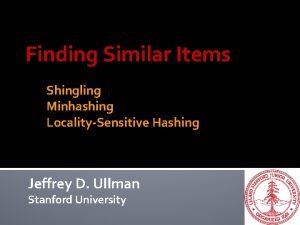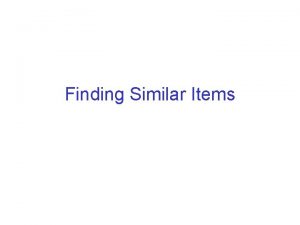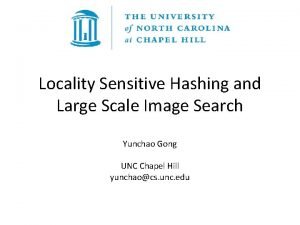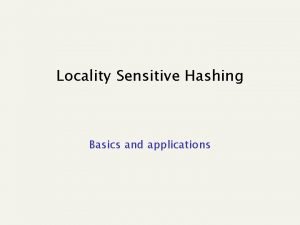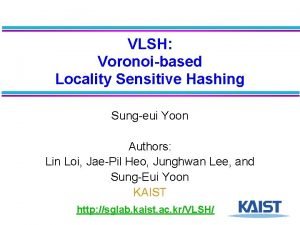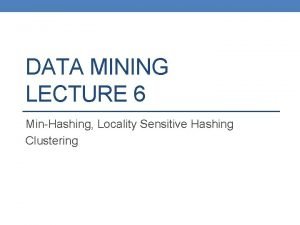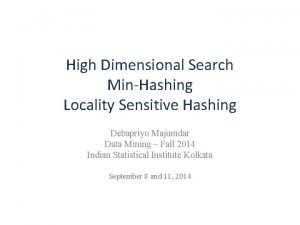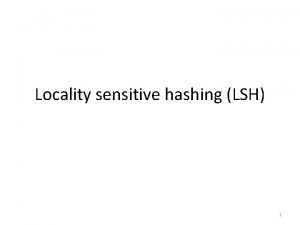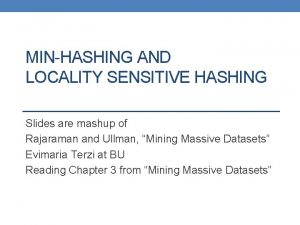Finding Similar Items Locality Sensitive Hashing CS 246

![[Hays and Efros, SIGGRAPH 2007] Scene Completion Problem 2/14/2022 Jure Leskovec, Stanford C 246: [Hays and Efros, SIGGRAPH 2007] Scene Completion Problem 2/14/2022 Jure Leskovec, Stanford C 246:](https://slidetodoc.com/presentation_image_h2/b7d4986c1d17102d09101ecde93c48eb/image-2.jpg)
![[Hays and Efros, SIGGRAPH 2007] Scene Completion Problem 2/14/2022 Jure Leskovec, Stanford C 246: [Hays and Efros, SIGGRAPH 2007] Scene Completion Problem 2/14/2022 Jure Leskovec, Stanford C 246:](https://slidetodoc.com/presentation_image_h2/b7d4986c1d17102d09101ecde93c48eb/image-3.jpg)
![[Hays and Efros, SIGGRAPH 2007] Scene Completion Problem 10 nearest neighbors from a collection [Hays and Efros, SIGGRAPH 2007] Scene Completion Problem 10 nearest neighbors from a collection](https://slidetodoc.com/presentation_image_h2/b7d4986c1d17102d09101ecde93c48eb/image-4.jpg)
![[Hays and Efros, SIGGRAPH 2007] Scene Completion Problem 2/14/2022 10 nearest neighbors from a [Hays and Efros, SIGGRAPH 2007] Scene Completion Problem 2/14/2022 10 nearest neighbors from a](https://slidetodoc.com/presentation_image_h2/b7d4986c1d17102d09101ecde93c48eb/image-5.jpg)





















![Surprising Property �Choose a random permutation �then Pr[h (C 1) = h (C 2)] Surprising Property �Choose a random permutation �then Pr[h (C 1) = h (C 2)]](https://slidetodoc.com/presentation_image_h2/b7d4986c1d17102d09101ecde93c48eb/image-27.jpg)
![Similarity for Signatures �We know: Pr[h (C 1) = h (C 2)] = sim(C Similarity for Signatures �We know: Pr[h (C 1) = h (C 2)] = sim(C](https://slidetodoc.com/presentation_image_h2/b7d4986c1d17102d09101ecde93c48eb/image-28.jpg)























- Slides: 51

Finding Similar Items: Locality Sensitive Hashing CS 246: Mining Massive Datasets Jure Leskovec, Stanford University http: //cs 246. stanford. edu
![Hays and Efros SIGGRAPH 2007 Scene Completion Problem 2142022 Jure Leskovec Stanford C 246 [Hays and Efros, SIGGRAPH 2007] Scene Completion Problem 2/14/2022 Jure Leskovec, Stanford C 246:](https://slidetodoc.com/presentation_image_h2/b7d4986c1d17102d09101ecde93c48eb/image-2.jpg)
[Hays and Efros, SIGGRAPH 2007] Scene Completion Problem 2/14/2022 Jure Leskovec, Stanford C 246: Mining Massive Datasets 2
![Hays and Efros SIGGRAPH 2007 Scene Completion Problem 2142022 Jure Leskovec Stanford C 246 [Hays and Efros, SIGGRAPH 2007] Scene Completion Problem 2/14/2022 Jure Leskovec, Stanford C 246:](https://slidetodoc.com/presentation_image_h2/b7d4986c1d17102d09101ecde93c48eb/image-3.jpg)
[Hays and Efros, SIGGRAPH 2007] Scene Completion Problem 2/14/2022 Jure Leskovec, Stanford C 246: Mining Massive Datasets 3
![Hays and Efros SIGGRAPH 2007 Scene Completion Problem 10 nearest neighbors from a collection [Hays and Efros, SIGGRAPH 2007] Scene Completion Problem 10 nearest neighbors from a collection](https://slidetodoc.com/presentation_image_h2/b7d4986c1d17102d09101ecde93c48eb/image-4.jpg)
[Hays and Efros, SIGGRAPH 2007] Scene Completion Problem 10 nearest neighbors from a collection of 20, 000 images 2/14/2022 Jure Leskovec, Stanford C 246: Mining Massive Datasets 4
![Hays and Efros SIGGRAPH 2007 Scene Completion Problem 2142022 10 nearest neighbors from a [Hays and Efros, SIGGRAPH 2007] Scene Completion Problem 2/14/2022 10 nearest neighbors from a](https://slidetodoc.com/presentation_image_h2/b7d4986c1d17102d09101ecde93c48eb/image-5.jpg)
[Hays and Efros, SIGGRAPH 2007] Scene Completion Problem 2/14/2022 10 nearest neighbors from a collection of 2 million images Jure Leskovec, Stanford C 246: Mining Massive Datasets 5

A Common Metaphor �Many problems can be expressed as finding “similar” sets: § Find near-neighbors in high-dimensional space �Examples: § Pages with similar words § For duplicate detection, classification by topic § Customers who purchased similar products § Products with similar customer sets § Images with similar features § Users who visited the similar websites 2/14/2022 Jure Leskovec, Stanford C 246: Mining Massive Datasets 6

Distance Measures �We formally define “near neighbors” as points that are a “small distance” apart �For each use case, we need to define what “distance” means �Today: Jaccard similarity/distance § The Jaccard Similarity/Distance of two sets is the size of their intersection / the size of their union: § sim(C 1, C 2) = |C 1 C 2|/|C 1 C 2| § d(C 1, C 2) = 1 - |C 1 C 2|/|C 1 C 2| 3 in intersection 8 in union Jaccard similarity= 3/8 Jaccard distance = 5/8 2/14/2022 Jure Leskovec, Stanford C 246: Mining Massive Datasets 7

Finding Similar Items

Finding Similar Documents �Goal: Given a large number (N in the millions or billions) of text documents, find pairs that are “near duplicates” �Applications: § Mirror websites, or approximate mirrors § Don’t want to show both in a search § Similar news articles at many news sites § Cluster articles by “same story” �Problems: § Many small pieces of one doc can appear out of order in another § Too many docs to compare all pairs § Docs are so large or so many that they cannot fit in main memory 2/14/2022 Jure Leskovec, Stanford C 246: Mining Massive Datasets 13

3 Essential Steps for Similar Docs 1. Shingling: Convert documents, emails, etc. , to sets 2. Minhashing: Convert large sets to short signatures, while preserving similarity 3. Locality-sensitive hashing: Focus on pairs of signatures likely to be from similar documents 2/14/2022 Jure Leskovec, Stanford C 246: Mining Massive Datasets 14

The Big Picture Document Shingling The set of strings of length k that appear in the document 2/14/2022 Locality. Sensitive Hashing Min Hashing Signatures: short integer vectors that represent the sets, and reflect their similarity Jure Leskovec, Stanford C 246: Mining Massive Datasets Candidate pairs: those pairs of signatures that we need to test for similarity. 15

Documents as High-Dim Data �Step 1: Shingling: Convert documents, emails, etc. , to sets �Simple approaches: § Document = set of words appearing in doc § Document = set of “important” words § Don’t work well for this application. Why? �Need to account for ordering of words �A different way: Shingles 2/14/2022 Jure Leskovec, Stanford C 246: Mining Massive Datasets 16

Define: Shingles �A k-shingle (or k-gram) for a document is a sequence of k tokens that appears in the doc § Tokens can be characters, words or something else, depending on application § Assume tokens = characters for examples �Example: k=2; D 1= abcab Set of 2 -shingles: S(D 1)={ab, bc, ca} § Option: Shingles as a bag, count ab twice 2/14/2022 Jure Leskovec, Stanford C 246: Mining Massive Datasets 17

Compressing Shingles �To compress long shingles, we can hash them to (say) 4 bytes �Represent a doc by the set of hash values of its k-shingles �Idea: Two documents could (rarely) appear to have shingles in common, when in fact only the hash-values were shared �Example: k=2; D 1= abcab Set of 2 -shingles: S(D 1)={ab, bc, ca} Hash the singles: h(D 1)={1, 5, 7} 2/14/2022 Jure Leskovec, Stanford C 246: Mining Massive Datasets 18

Can skip the discussion of the 0/1 vector – keep that for later Similarity Metric for Shingles �Document D 1 = set of k-shingles C 1=S(D 1) �Equivalently, each document is a 0/1 vector in the space of k-shingles § Each unique shingle is a dimension § Vectors are very sparse �A natural similarity measure is the Jaccard similarity: Sim(D 1, D 2) = |C 1 C 2|/|C 1 C 2| 2/14/2022 Jure Leskovec, Stanford C 246: Mining Massive Datasets 19

Working Assumption SKIP! �Documents that have lots of shingles in common have similar text, even if the text appears in different order �Careful: You must pick k large enough, or most documents will have most shingles § k = 5 is OK for short documents § k = 10 is better for long documents 2/14/2022 Jure Leskovec, Stanford C 246: Mining Massive Datasets 20

Motivation for Minhash/LSH �Suppose we need to find near-duplicate documents among N=1 million documents �Naïvely, we’d have to compute pairwaise Jaccard similarites for every pair of docs § i. e, N(N-1)/2 ≈ 5*1011 comparisons § At 105 secs/day and 106 comparisons/sec, it would take 5 days �For N = 10 million, it takes more than a year… 2/14/2022 Jure Leskovec, Stanford C 246: Mining Massive Datasets 21

Document Min. Hashing Shingling The set of strings of length k that appear in the document Signatures: short integer vectors that represent the sets, and reflect their similarity Min. Hashing Step 2: Minhashing: Convert large sets to short signatures, while preserving similarity

Encoding Sets as Bit Vectors � Many similarity problems can be formalized as finding subsets hat have significant intersection � Encode sets using 0/1 (bit, boolean) vectors § One dimension per element in the universal set � Interpret set intersection as bitwise AND, and set union as bitwise OR � Example: C 1 = 10111; C 2 = 10011 § Size of intersection = 3; size of union = 4, Jaccard similarity (not distance) = 3/4 § d(C 1, C 2) = 1 – (Jaccard similarity) = 1/4 2/14/2022 Jure Leskovec, Stanford C 246: Mining Massive Datasets 23

SKIP! Compress the slides where we construct the binary matrix (keep next slide but remove this one) From Sets to Boolean Matrices �Rows = elements of the universal set �Columns = sets � 1 in row e and column s if and only if e is a member of s �Column similarity is the Jaccard similarity of the sets of their rows with 1 �Typical matrix is sparse 2/14/2022 Jure Leskovec, Stanford C 246: Mining Massive Datasets 1 1 1 0 1 0 1 1 0 1 0 24

Skip the NOTE (combine the slide with the previous one) Example: Jaccard of Columns �Each document is a column: § Size of intersection = 2; size of union = 5, Jaccard similarity (not distance) = 2/5 § d(C 1, C 2) = 1 – (Jaccard similarity) = 3/5 shingles § Example: C 1 = 1100011; C 2 = 0110010 1 0 1 1 0 0 0 1 Note: 0 0 0 1 �We might not really represent 1 1 1 0 the data by a boolean matrix 1 0 �Sparse matrices are usually documents better represented by the list of places where there is a non-zero value 2/14/2022 Jure Leskovec, Stanford C 246: Mining Massive Datasets 25

Outline: Finding Similar Columns �So far: § Documents Sets of shingles § Represent sets as boolean vectors in a matrix �Next Goal: Find similar columns, Small signatures �Approach: § 1) Signatures of columns: small summaries of columns § 2) Examine pairs of signatures to find similar columns § Essential: Similarities of signatures & columns are related § 3) Optional: check that columns with similar sigs. are really similar �Warnings: § Comparing all pairs may take too much time: job for LSH § These methods can produce false negatives, and even false positives (if the optional check is not made) 2/14/2022 Jure Leskovec, Stanford C 246: Mining Massive Datasets 26

Hashing Columns (Singatures) �Key idea: “hash” each column C to a small signature h(C), such that: § (1) h(C) is small enough that the signature fits in RAM § (2) sim(C 1, C 2) is the same as the “similarity” of signatures h(C 1) and h(C 2) �Goal: Find a hash function h() such that: § if sim(C 1, C 2) is high, then with high prob. h(C 1) = h(C 2) § if sim(C 1, C 2) is low, then with high prob. h(C 1) ≠ h(C 2) �Hash docs into buckets, and expect that “most” pairs of near duplicate docs hash into the same bucket 2/14/2022 Jure Leskovec, Stanford C 246: Mining Massive Datasets 27

Min-Hashing �Goal: Find a hash function h() such that: § if sim(C 1, C 2) is high, then with high prob. h(C 1) = h(C 2) § if sim(C 1, C 2) is low, then with high prob. h(C 1) ≠ h(C 2) �Clearly, the hash function depends on the similarity metric: § Not all similarity metrics have a suitable hash function �There is a suitable hash function for Jaccard similarity: Min-hashing 2/14/2022 Jure Leskovec, Stanford C 246: Mining Massive Datasets 28

Min-Hashing �Imagine the rows of the boolean matrix permuted under random permutation �Define a “hash” function h (C) = the number of the first (in the permuted order ) row in which column C has value 1: h (C) = min (C) �Use several (e. g. , 100) independent hash functions to create a signature of a column 2/14/2022 Jure Leskovec, Stanford C 246: Mining Massive Datasets 29

Min-Hashing Example Permutation Input matrix (Shingles x Documents) Have a better example! The index is of the original row not that of the permutation! See http: //www. stanford. edu/class/archive/cs/ Signature matrix M cs 276 a/cs 276 a. 1032/ handouts/minhash 6 in 1. pdf For a better example 1 4 3 1 0 2 1 3 2 4 1 0 0 1 7 0 1 2 1 4 1 6 3 6 0 1 1 2 2 6 1 0 1 5 7 2 1 0 4 5 5 1 0 2/14/2022 Jure Leskovec, Stanford C 246: Mining Massive Datasets 30
![Surprising Property Choose a random permutation then Prh C 1 h C 2 Surprising Property �Choose a random permutation �then Pr[h (C 1) = h (C 2)]](https://slidetodoc.com/presentation_image_h2/b7d4986c1d17102d09101ecde93c48eb/image-27.jpg)
Surprising Property �Choose a random permutation �then Pr[h (C 1) = h (C 2)] = sim(C 1, C 2) �Why? § Let X be a set of shingles, X [264], x X § Then: Pr[ (y) = min( (X))] = 1/|X| 0 0 1 1 0 This proof was not clear at all!! Add slides about types of rows A, B, C an the proof § It is equally likely that any y X is mapped to the min element § Let x be s. t. (x) = min( (C 1 C 2)) § Then either: (x) = min( (C 1)) if x C 1 , or (x) = min( (C 2)) if x C 2 § So the prob. that both are true is the prob. x C 1 C 2 § Pr[min( (C 1))=min( (C 2))]=|C 1 C 2|/|C 1 C 2|= sim(C 1, C 2) 2/14/2022 Jure Leskovec, Stanford C 246: Mining Massive Datasets 31
![Similarity for Signatures We know Prh C 1 h C 2 simC Similarity for Signatures �We know: Pr[h (C 1) = h (C 2)] = sim(C](https://slidetodoc.com/presentation_image_h2/b7d4986c1d17102d09101ecde93c48eb/image-28.jpg)
Similarity for Signatures �We know: Pr[h (C 1) = h (C 2)] = sim(C 1, C 2) �Now generalize to multiple hash functions �The similarity of two signatures is the fraction of the hash functions in which they agree �Note: Because of the minhash property, the similarity of columns is the same as the expected similarity of their signatures 2/14/2022 Jure Leskovec, Stanford C 246: Mining Massive Datasets 32

Min Hashing – Example Input matrix Signature matrix M 1 4 3 1 0 2 1 3 2 4 1 0 0 1 7 0 1 2 1 4 1 6 3 6 0 1 1 2 2 6 1 0 1 5 7 2 1 0 4 5 5 1 0 2/14/2022 Similarities: 1 -3 2 -4 1 -2 3 -4 Col/Col 0. 75 0 0 Sig/Sig 0. 67 1. 00 0 0 Jure Leskovec, Stanford C 246: Mining Massive Datasets 33

Min. Hash Signatures Include implementational trick – permuting rows is expensive. Do it by using a hash function http: //www. stanford. edu/class/archive/cs/ cs 276 a/cs 276 a. 1032/ handouts/minhash 6 in 1. pdf �Pick 100 random permutations of the rows �Think of sig(C) as a column vector �Let sig(C)[i] = according to the i-th permutation, the index of the first row that has a 1 in column C sig(C)[i] = min ( i(C)) �Note: The sketch (signature) of document C is small -- ~100 bytes! § We achieved our goal! We “compressed” long bit vectors into short signatures 2/14/2022 Jure Leskovec, Stanford C 246: Mining Massive Datasets 34

Document Min. Hashing Shingling The set of strings of length k that appear in the document Localitysensitive Hashing Signatures: short integer vectors that represent the sets, and reflect their similarity Candidate pairs: those pairs of signatures that we need to test for similarity. Locality Sensitive Hashing Step 3: Locality-sensitive hashing: Focus on pairs of signatures likely to be from similar documents

LSH: First Cut 2 1 4 1 1 2 2 1 �Goal: Find documents with Jaccard similarity at least s (for some similarity threshold, e. g. , s=0. 8) �LSH – General idea: Use a function f(x, y) that tells whether x and y is a candidate pair: a pair of elements whose similarity must be evaluated �For minhash matrices: § Hash columns of signature matrix M to many buckets § Each pair of documents that hashes into the same bucket is a candidate pair 2/14/2022 Jure Leskovec, Stanford C 246: Mining Massive Datasets 36

Candidates from Minhash 2 1 is this 4 – each 1 Why column with prob P, so 2 why fraction 1 of 2 values 1 2 1 �Pick a similarity threshold s, a fraction < 1 �Columns x and y of M are a candidate pair if their signatures agree on at least fraction s of their rows: M (i, x) = M (i, y) for at least frac. s values of i § We expect documents x and y to have the same similarity as their signatures 2/14/2022 Jure Leskovec, Stanford C 246: Mining Massive Datasets 37

LSH for Minhash 2 1 4 1 1 2 2 1 �Big idea: Hash columns of signature matrix M several times �Arrange that (only) similar columns are likely to hash to the same bucket, with high probability �Candidate pairs are those that hash to the same bucket 2/14/2022 Jure Leskovec, Stanford C 246: Mining Massive Datasets 38

Partition M into Bands 2 1 4 1 1 2 2 1 r rows per band b bands One signature Signature matrix M 2/14/2022 Jure Leskovec, Stanford C 246: Mining Massive Datasets 39

Partition M into Bands �Divide matrix M into b bands of r rows �For each band, hash its portion of each column to a hash table with k buckets § Make k as large as possible �Candidate column pairs are those that hash to the same bucket for ≥ 1 band �Tune b and r to catch most similar pairs, but few non-similar pairs 2/14/2022 Jure Leskovec, Stanford C 246: Mining Massive Datasets 40

Hashing Bands Columns 2 and 6 are probably identical (candidate pair) Buckets Columns 6 and 7 are surely different. Matrix M r rows 2/14/2022 Jure Leskovec, Stanford C 246: Mining Massive Datasets b bands 41

Simplifying Assumption �There are enough buckets that columns are unlikely to hash to the same bucket unless they are identical in a particular band �Hereafter, we assume that “same bucket” means “identical in that band” �Assumption needed only to simplify analysis, not for correctness of algorithm 2/14/2022 Jure Leskovec, Stanford C 246: Mining Massive Datasets 42

Example of Bands 2 1 4 1 1 2 2 1 Assume the following case: �Suppose 100, 000 columns of M (100 k docs) �Signatures of 100 integers (rows) �Therefore, signatures take 40 Mb �Choose 20 bands of 5 integers/band �Goal: Find pairs of documents that are at least s = 80% similar 2/14/2022 Jure Leskovec, Stanford C 246: Mining Massive Datasets 43

C 1, C 2 are 80% Similar 2 1 4 1 1 2 2 1 �Assume: C 1, C 2 are 80% similar § Since s=80% we want C 1, C 2 to hash to at least one common bucket (at least one band is identical) �Probability C 1, C 2 identical in one particular band: (0. 8)5 = 0. 328 �Probability C 1, C 2 are not similar in all of the 20 bands: (1 -0. 328)20 = 0. 00035 § i. e. , about 1/3000 th of the 80%-similar column pairs are false negatives § We would find 99. 965% pairs of truly similar documents 2/14/2022 Jure Leskovec, Stanford C 246: Mining Massive Datasets 44

C 1, C 2 are 30% Similar 2 1 4 1 1 2 2 1 �Assume: C 1, C 2 are 30% similar § Since s=80% we want C 1, C 2 to hash to at NO common buckets (all bands should be different) �Probability C 1, C 2 identical in one particular band: (0. 3)5 = 0. 00243 �Probability C 1, C 2 identical in at least 1 of 20 bands: 1 - (1 - 0. 00243)20 = 0. 0474 § In other words, approximately 4. 74% pairs of docs with similarity 30% end up becoming candidate pairs -- false positives 2/14/2022 Jure Leskovec, Stanford C 246: Mining Massive Datasets 45

LSH Involves a Tradeoff 2 1 4 1 1 2 2 1 �Pick: § the number of minhashes (rows of M) § the number of bands b, and § the number of rows r per band to balance false positives/negatives �Example: if we had only 15 bands of 5 rows, the number of false positives would go down, but the number of false negatives would go up 2/14/2022 Jure Leskovec, Stanford C 246: Mining Massive Datasets 46

************ �Make a point about the step function �And the linear sum=collision prob. And now we amplify the hash function § And that rows and bands are doing exactly that! 2/14/2022 Jure Leskovec, Stanford C 246: Mining Massive Datasets 47

Analysis of LSH – What We Want Probability = 1 if s > t Probability of sharing a bucket No chance if s < t t Similarity s of two sets 2/14/2022 Jure Leskovec, Stanford C 246: Mining Massive Datasets 48

What 1 Band of 1 Row Gives You Remember: Probability of equal hash-values = similarity Probability of sharing a bucket t Similarity s of two sets 2/14/2022 Jure Leskovec, Stanford C 246: Mining Massive Datasets 49

SKIP this calculatipon b bands, r rows/band �Columns C 1 and C 2 have similarity s �Pick any band (r rows) § Prob. that all rows in band equal = sr § Prob. that some row in band unequal = 1 - sr �Prob. that no band identical = (1 - s r)b �Prob. that at least 1 band identical = 1 - (1 - s r)b 2/14/2022 Jure Leskovec, Stanford C 246: Mining Massive Datasets 50

What b Bands of r Rows Gives You At least one band identical t ~ (1/b)1/r Probability of sharing a bucket t No bands identical 1 - (1 - s r )b Some row of a band unequal All rows of a band are equal Similarity s of two sets 2/14/2022 Jure Leskovec, Stanford C 246: Mining Massive Datasets 51

Example: b = 20; r = 5 �Similarity threshold s �Prob. that at least 1 band identical: s. 2. 3. 4. 5. 6. 7. 8 2/14/2022 1 -(1 -sr)b. 006. 047. 186. 470. 802. 975. 9996 Jure Leskovec, Stanford C 246: Mining Massive Datasets 52

Picking r and b: The S-curve �Picking r and b to get the best S-curve Prob. sharing a bucket § 50 hash-functions (r=5, b=10) Blue area: False Negative rate Green area: False Positive rate Similarity 2/14/2022 Jure Leskovec, Stanford C 246: Mining Massive Datasets 53

LSH Summary �Tune to get almost all pairs with similar signatures, but eliminate most pairs that do not have similar signatures �Check in main memory that candidate pairs really do have similar signatures �Optional: In another pass through data, check that the remaining candidate pairs really represent similar documents 2/14/2022 Jure Leskovec, Stanford C 246: Mining Massive Datasets 54

Summary: 3 Steps 1. Shingling: Convert documents, emails, etc. , to sets 2. Minhashing: Convert large sets to short signatures, while preserving similarity 3. Locality-sensitive hashing: Focus on pairs of signatures likely to be from similar documents 2/14/2022 Jure Leskovec, Stanford C 246: Mining Massive Datasets 55
 Static and dynamic hashing in dbms
Static and dynamic hashing in dbms Linear probing hash table
Linear probing hash table Linear hashing
Linear hashing Dynamic hashing
Dynamic hashing Mosby items and derived items
Mosby items and derived items Mosby items and derived items
Mosby items and derived items Acuity charting forms
Acuity charting forms Mosby items and derived items
Mosby items and derived items Mosby items and derived items
Mosby items and derived items Mosby items and derived items
Mosby items and derived items Mosby items and derived items
Mosby items and derived items Mosby items and derived items
Mosby items and derived items Absorption atelectasis
Absorption atelectasis Lliver
Lliver Mosby items and derived items
Mosby items and derived items Mosby items and derived items
Mosby items and derived items Mosby items and derived items
Mosby items and derived items Mosby items and derived items
Mosby items and derived items Mosby items and derived items
Mosby items and derived items Mosby items and derived items
Mosby items and derived items Caudal region of the body
Caudal region of the body Mosby items and derived items
Mosby items and derived items Mosby items and derived items
Mosby items and derived items Mosby items and derived items
Mosby items and derived items Mosby items and derived items
Mosby items and derived items Mosby items and derived items
Mosby items and derived items Mosby items and derived items
Mosby items and derived items Mosby items and derived items
Mosby items and derived items Mosby items and derived items
Mosby items and derived items Reproductive system
Reproductive system Mosby items and derived items
Mosby items and derived items Finding frequent items in data streams
Finding frequent items in data streams What is 239 rounded to the nearest hundred
What is 239 rounded to the nearest hundred Cs246 mining massive data sets
Cs246 mining massive data sets Ds. p. van veen
Ds. p. van veen En un zoológico hay 246 aves
En un zoológico hay 246 aves Mining massive datasets
Mining massive datasets Place value of 246
Place value of 246 Redondear al dolar mas cercano
Redondear al dolar mas cercano It 246
It 246 Cs 246
Cs 246 Cs 246
Cs 246 Afman 10-246
Afman 10-246 246 regel diabetes
246 regel diabetes Unidad de medida de solubilidad
Unidad de medida de solubilidad Similar
Similar Similar disuelve a similar
Similar disuelve a similar Members of an avian species of identical plumage congregate
Members of an avian species of identical plumage congregate Introduction to plastic pollution
Introduction to plastic pollution Locality of reference
Locality of reference Sketch all serious crime and crash scenes:
Sketch all serious crime and crash scenes: Spatial locality
Spatial locality
